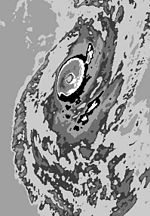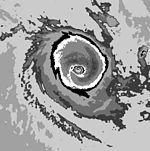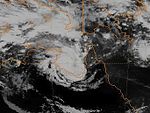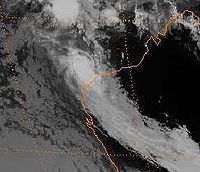- 1980–85 Southern Hemisphere tropical cyclone seasons
-
The 1980-1985 Southern Hemisphere tropical cyclone seasons ran year-round from July 1 to June 30 during each year between 1980 and 1985. Tropical cyclone activity in the Southern Hemisphere reaches its peak from mid-February to early March.
1980–81 Southern Hemisphere tropical cyclone season
Cyclone Cliff
After ravaging the South Pacific islands, Cyclone Cliff struck Queensland on February 14, 1981. The effects of the cyclone was felt from Noosa to Burleigh Heads on the Gold Coast. One person died in the storm.[1]
Cyclone Max
Cyclone Max developed from a low pressure system into a Category 1 cyclone in Van Diemen Gulf, off the Northern Territory Coast, on March 11, 1981. Moving west-southwest, it crossed over Darwin, Australia later that day, causing tree damage and flooding but minimal structural damage. It subsequently moved west into the Timor Sea and the Indian Ocean, and although intensifying to Category 3 and reaching a lowest pressure of 960.0 hectopascals (28.35 inHg), did not approach land again.[2] Max was remarkable for being the first cyclone to pass over Darwin since the city was destroyed by Cyclone Tracy 6 years earlier. The name Max was not retired from the Northern Australia naming list.
1981–82 Southern Hemisphere tropical cyclone season
Cyclone Errol
Errol caused heavy damage in Western Australia in January 1982.[3]
Cyclone Isaac
Category 3 severe tropical cyclone (Australian scale) 
Duration February 28 – March 3 Intensity 150 km/h (90 mph) (10-min), Unknown The tropical cyclone developed 160 km/100 mi northeast of western Samoa and travelled southwest at 12 knots, moving through the Ha'apai island group and only 50 km/30 mi northwest of Tongatapu. The pressure at Tongatapu fell to 976.4 mbar (28.83 inHg). Winds of 92 knots were measured at Nuku'alofa,[4] and rainfall of 120 millimetres (4.7 in) was measured there. Isaac reached maximum intensity on March 2. The tropical cyclone was the worst storm in Tonga's history, devastating the island group.[5] The island groups of Ha'apai and Vava'u were hit worst. Six were killed [4], while 45,000 became homeless and 95% of the livestock was killed.[6] The island of Tatafa was bisected in half by a 16 metres (52 ft) wide channel caused by Isaac's storm surge.[7]
Cyclone Dominic
Category 4 severe tropical cyclone (Australian scale) 
Duration April 4 – April 14 Intensity 165 km/h (105 mph) (10-min), Unknown Cyclone Dominic made landfall on April 7, 1982 near Cape Keerweer. Damage was done to buildings and power lines at Edward River Mission and Aurukun. Wind damage was seen in Darwin and the Northern Territory. The storm tide was 1 meter/3.3 ft at Weripa and 1.5 meter/5 ft at Karumba.[8] The storm left 3.6 million dollars (1982 USD) in damage.[9]
1982–83 Southern Hemisphere tropical cyclone season
Cyclone Jane
Jane formed on January 3, 1983 near Indonesia. The storm moved southward where it reached Category 1 status on the same day. Jane did a small loop before continuing south-eastward. Jane reached Category 4 status before making landfall east of Port Hedland, Western Australia. Jane then dissipated after January 10.[10]
Cyclone Elinor
In March,1983, Cyclone Elinor made landfall in Queensland wrecking two yachts.[11]
Cyclone Ken
Ken formed on February 28, 1983 several hundred miles north of Australia. The storm briefly reached Category 3 status before making landfall in the sparsely populated area. The storm dissipated well inland by March 6.[12]
Cyclone Lena
Lena formed off the coast of Indonesia on April 3, 1983. The storm reached Category 2 status before making landfall at Port Hedland, Australia. The storm dissipated on April 9.
1983–84 Southern Hemisphere tropical cyclone season
Cyclone Grace
Grace struck Queensland on January 1, 1984 causing $7 million (1998 USD) in damage.[13]
Cyclone Chloe
On 29 February 1984 Chloe crossed the coast near Roebourne, Western Australia where three houses were destroyed and twelve others unroofed. Fifty people required evacuation as floodwaters from the Harding River rose to the lower steps of the Police Station. Parts of the Wickham High School were severely damaged and two buildings and a boat were destroyed in the Cossack/Point Samson area. The Dampier Yacht Club was unroofed.[14]
Cyclone Kathy
Category 5 severe tropical cyclone (Australian scale) Category 4 tropical cyclone (SSHS) 

Duration March 18 – March 24 Intensity 205 km/h (125 mph) (10-min), Unknown Main article: Cyclone KathySevere Tropical Cyclone Kathy was a powerful tropical cyclone that devastated the Sir Edward Pellew Group of Islands in March 1984. Originating from a tropical low off the southern coast of Papua New Guinea. Tracking westward, the system attained gale-force winds by 18 March before striking the Cape York Peninsula. After crossing the area, Kathy entered the Gulf of Carpentaria where environmental conditions favoured significant development. On 22 March, the storm attained its peak intensity as a Category 5 severe tropical cyclone (Australian tropical cyclone intensity scale) with ten-minute sustained winds of 205 km/h (125 mph). By this time, the storm had been tracking towards the southwest and struck the Sir Edward Pellew Group of Islands later on 22 March before moving over the Australian mainland as a slightly weaker system. Once over land, Kathy rapidly degraded, losing gale-force winds within 24 hours; the storm dissipated over the Northern Territory on 24 March.
Cyclone Domoina
Main article: Tropical Storm DomoinaCyclone Domoina struck the east coast of Mozambique and South Africa in late January causing severe flooding. Floods in Mozambique, Swaziland and northeastern South Africa killed over 200 people. [15]
Cyclone Kamisy
Cyclone Kamisy struck northern Madagascar on April 8 with winds of 115 mph. 82 people were killed and 100,000 were left homeless. Damage in the area was enormous, totaling to more than 150 million (1984 USD). [16]
1984–85 Southern Hemisphere tropical cyclone season
Cyclone Emma
A Category 3 cyclone, Emma struck Western Australia on December 12, 1984 as a Category 1 cyclone.[17]
Cyclone Rebecca
Rebecca made landfall in Queensland on February 22, 1985 as a Category 1 storm.[18]
Cyclone Lindsay
Cyclone Lindsay formed on March 6, 1985. The storm moved south-southeast reaching Category 4 status before making landfall near Broome, Western Australia.[19]
Cyclone Gretel
Cyclone Gretel was a tropical cyclone that formed in the Arafura Sea late on April 12, 1985, just east of Croker Island, off the Northern Territory coast. Moving in a west-southwest direction, it crossed the Cobourg Peninsula into the Van Diemen Gulf, where it intensified to Category 2 and reached its lowest pressure of 984 hPa. Moving south-west, the eye of the storm passed over Darwin, Australia, early on April 14, causing extensive tree damage and flooding to the area but no reported loss of life. It continued moving in a south-southwest direction, weakening to a low pressure system near the Victoria River mouth late that evening.[1] The total estimated damages was $3.5 million.[20] The name Gretel has not been retired from the Northern Australia naming list.
See also
References
- ^ Noosa to Burleigh Heads, Qld: Cyclone (incl. Storm Surge)
- ^ http://australiasevereweather.com/cyclones/1981/bom/max.gif
- ^ WA: Cyclone
- ^ a b Dirk H.R. Spennemann, Conservation management and mitigation of the impact of tropical cyclones
- ^ Tonga - History
- ^ Tonga in the News
- ^ James P. Terry (2007). Tropical cyclones: climatology and impacts in the South Pacific. Springer. p. 111. ISBN 9780387715421. http://books.google.com/books?id=syqPSpliRCwC&pg=PA111&dq=cyclone+isaac+1982&hl=en&ei=E_1mTaXHA8WclgfW1tmBAg&sa=X&oi=book_result&ct=result&resnum=2&sqi=2&ved=0CC4Q6AEwAQ#v=onepage&q=cyclone%20isaac%201982&f=false. Retrieved 2011-02-24.
- ^ Gulf of Carpentaria, Qld/NT: Cyclone
- ^ Gulf of Carpentaria, Qld/NT: Cyclone
- ^ http://australiasevereweather.com/cyclones/1983/bom/jane.gif
- ^ Central Coastal Qld, Cyclone (incl Storm Surge)
- ^ http://australiasevereweather.com/cyclones/1983/bom/ken.gif
- ^ Qld: Cyclone
- ^ BoM - Tropical Cyclones affecting Karratha/Dampier
- ^ 1
- ^ The Weather Doctor's Diary: April
- ^ http://australiasevereweather.com/cyclones/1985/bom/emma.gif
- ^ http://australiasevereweather.com/cyclones/1985/bom/rebecca.gif
- ^ http://australiasevereweather.com/cyclones/1985/bom/lindsay.gif
- ^ Darwin, NT: Cyclone
External links
Categories:- Hurricane articles without infoboxes
- 1980–85 Southern Hemisphere tropical cyclone seasons
Wikimedia Foundation. 2010.





